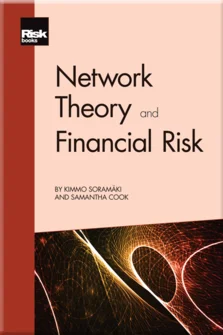Market Risk: Asset Correlation Networks
Introduction to Financial Networks
Creating and Describing Networks
Identifying Important Nodes: Centrality Metrics
Uncovering Latent Structure: Clustering and Community Detection
Finding Hidden Links: Projection Networks
Fast Insights: Visualising Networks
Financial Cartography: Network Layouts
Brass Tacks: Complexity Reduction
Market Risk: Asset Correlation Networks
Liquidity and Operational Risk: Interbank Payment Networks
Counterparty and Systemic Risk: Exposure Networks
Any correlation matrix (and, more broadly, any dependence matrix) can be considered as a complete network (as shown in Chapter 2), with the rows/columns as nodes and the correlation between each pair of nodes stored as a link property. In finance, correlation networks are often calculated from time series of asset returns. Common analysis goals for such data are to find the most important correlations, group the nodes into communities based on a reduced network, and monitor changes in the network over time. This chapter will take a detailed look at the analysis of correlation networks, focusing on price data. We will illustrate the creation of correlation networks from time series data and provide examples of complexity reduction and visualisation. Interactive applications using correlation trees for outlier detection will illustrate these concepts with real data.
Throughout this chapter we will refer to assets, which may represent stocks, exchange rates, bond yields, economic indicators, factors, etc. The type of analysis presented here allows portfolio managers, risk managers and economists to identify price-driving themes and market dynamics, to reduce complexity of the
Copyright Infopro Digital Limited. All rights reserved.
As outlined in our terms and conditions, https://www.infopro-digital.com/terms-and-conditions/subscriptions/ (point 2.4), printing is limited to a single copy.
If you would like to purchase additional rights please email info@risk.net
Copyright Infopro Digital Limited. All rights reserved.
You may share this content using our article tools. As outlined in our terms and conditions, https://www.infopro-digital.com/terms-and-conditions/subscriptions/ (clause 2.4), an Authorised User may only make one copy of the materials for their own personal use. You must also comply with the restrictions in clause 2.5.
If you would like to purchase additional rights please email info@risk.net











